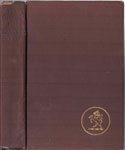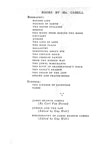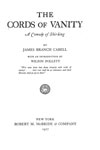James Branch Cabell : An Illustrated Bibliography
THE CORDS OF VANITY: A Comedy of Shirking
Hall Code |
Description |
CoV-C5 (K) |
Fifth Printing, Revised Edition |
COMPILATION
Full Title:
Title page recto: THE | CORDS OF VANITY | [in italic] A Comedy of Shirking | [rule] | By | JAMES BRANCH CABELL | WITH AN INTRODUCTION BY | WILSON FOLLETT | [in italic] "Woe unto them that draw iniquity with cords of | vanity! . . . their root shall be as rottenness and their | blossom shall go up as dust." | [McBride Liberty Bell device] | NEW YORK | ROBERT M. McBRIDE & CO. | 1927 (see image above).
Title page verso: REVISED EDITION, COPYRIGHT, 1920 | BY JAMES BRANCH CABELL | [in italic] Fifth Printing, August, 1927 | THE CORDS OF VANITY | [rule] | PRINTED IN THE UNITED STATES OF AMERICA (see image above).
Publication:
New York: Robert M. McBride & Company, August, 1927
Collation:
Crown octavo [ 19.2 cm. (7 9/16 in.) x 13.3 cm (5¼ in.)]; Pp. xvi + 330 + 3 blank leaves; (i) half-title; (ii) BOOKS by MR. CABELL; (iii) title page; (iv) publication data; (v) dedication (verso blank); (vii) fly-title: AN INTRODUCTION (verso blank); ix-xiv text of Introduction; xv CONTENTS (verso blank); (1) fly-title: THE PROLOGUE (verso blank); 3-330 text; 3 blank leaves. Pages (vii) and (1) are fly-titles. Pages (vi), (viii), (xvi), (2), and (12) are blank.
Binding:
Kalki binding: red-brick cloth, gilt lettering and decorations on spine and front cover, top edge trimmed, else untrimmed. Spine: THE | CORDS | OF | VANITY | [rule] | CABELL | McBRIDE; Front cover: Kalki device at lower right (see image above).
Dedication:
[rule] To | GABRIELLE BROOKE MONCURE | [in italic] Plus sapis vulgus, quia tantum, quantum | opus est, sapit. | [rule] (see image above).
Dust jacket:
Not seen.
Notes:
The quotation on the title page is from Isaiah 5:18 of the King James Version of the Bible. The Latin phrase in the dedication translates as “The common people are wise because they know only as much as is necessary.”
In the latter half of the 1920s, for no clear reason*, some printings in McBride's Kalki series were issued in bindings that lacked the “Kalki logo” in the lower right corner of the front board. In other ways – size, trim, cloth and the characteristic brick-brown color – they were the same as the standard Kalki bindings which did bear the logo. The generally meticulous Hall makes no mention of logo-less Kalki bindings – perhaps he just never happened to encounter any, though that would be surprising since such bindings for five different titles have come our way without our seeking them.
Kalki bindings sans logo:
*Chiv-B3a (K) – Chivalry (1926), 3rd printing
*CoV-C5a (K) – The Cords of Vanity (1927), 5th printing
Riv-A8 (K) – The Rivet in Grandfather’s Neck (1928), 8th printing
CH-A4 (K) – The Certain Hour (1929), 4th printing
*CoJ-A9(K) – The Cream of the Jest (1930), 9th printing
The 1926 third Kalki printing of Chivalry, the 1927 fifth Kalki printing of The Cords of Vanity, and the 1930 ninth printing of The Cream of the Jest exist in both states, with and without logo. Therefore we have designated the logo-less issues as binding variants and assigned them new ‘Hall numbers’: *Chiv-B3a (K), *CoV-B5a (K), and *CoJ-A9a (K). The other titles lacking the logo will retain the regular Hall number for their printing until or unless we can verify the existence a copy from that printing bearing the logo.
It is clear that this was not a series-wide policy after 1925, as the new publications of The Silver Stallion (1926) and Something About Eve (1927), as well as reprints of (for instance) Gallantry (1927), Jurgen (1928), and Beyond Life (1930) do display the Kalki logo in the accustomed place.
--------------
*We can speculate. Perhaps McBride used several different binderies but possessed a limited number of Kalki ‘stamps’ for impressing the logo. Certain later reprints were assigned to the stamp-less bindery and no one thought it worth the trouble to bring a stamp over from another bindery. It is notable that each of the five logo-less printings represents the final Kalki issue for that title.




